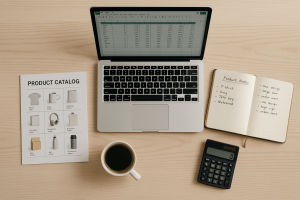One of the most common questions we hear from new sellers is:
“Can I really get started with wholesale if I don’t have thousands to invest?”
The answer is a resounding yes.
You do not need a huge budget, a business loan, or a pile of savings to launch a successful Amazon wholesale business. In fact, many of our most successful students started with less than $1,000 and a focused approach.
Having a smaller budget can actually work to your advantage. It pushes you to be more thoughtful, more selective, and more careful with every decision. These are the exact habits that help sellers thrive over time.
Start Small, Think Smart
When you are working with limited capital, the best thing you can do is test wisely. Wholesale is not about gambling on one product. It is about gathering data, learning what works, and building up your wins.
Your first $1,000 is not meant to turn you into a millionaire. Its job is to help you understand how to evaluate suppliers, how to spot a good listing, and how to build a repeatable process. This is how you start laying the foundation for long-term growth.
The goal at the beginning is not to scale quickly. It is to take smart, low-risk steps that give you valuable experience.
How to Use Your First $1,000 Effectively
We always recommend spreading your investment across multiple test buys. This helps you minimize risk and gives you more chances to find a winner.
 Here is one way to break it down:
Here is one way to break it down:
- Test 5 to 10 products or brands
- Spend about $100 to $200 on each one
- Work with suppliers who allow small minimum orders
- Choose listings that already show steady sales
This approach lets you dip your toes in the water without diving in headfirst. You get to see which suppliers communicate well, which brands ship on time, and which products actually sell.
It is a bit like dating. You are not trying to commit forever. You are just learning what kind of partnerships you want to build.
The $1,000 Seller’s Risk Checklist
If your budget is tight, your margin for error is small. That means every decision matters. Use this checklist to protect your investment and make smart moves:
 Avoid listings where Amazon is a seller more than 25% of the time
Avoid listings where Amazon is a seller more than 25% of the time
When Amazon is on a listing, they usually win the Buy Box. You want to avoid direct competition with them whenever possible.- Look for at least three other FBA sellers
A healthy listing usually has several sellers sharing the Buy Box. If you are the only seller, there may be a hidden restriction or limited demand. - Check for price stability
Use a tool like Keepa to make sure the price has not dropped more than 10 percent over the last 90 days. Stable prices lead to more reliable profits. - Stick with products priced between $17.99 and $49.99
These items are affordable for customers but still allow you to earn a solid return. They also require less capital to test.
Following these guidelines will not eliminate all risk, but they can help you avoid the biggest mistakes and give you a better shot at success.
Three Starter Product Ideas That Fit a Tight Budget
You do not need to chase trendy products or get into competitive categories to start strong. Some of the best beginner-friendly items are simple, practical, and often overlooked.
1. Kitchen and Dining: Branded Silicone Baking Mats
These are easy to source and lightweight, which means low shipping costs. They usually sell in the $20 to $30 range and tend to be reordered regularly.
2. Sports and Outdoors: Resistance Band Sets
Compact, profitable, and popular all year. Many brands offer versions you can bundle or improve slightly to stand out. These make great starter items for testing demand.
3. Industrial and Scientific: Blue Nitrile Disposable Gloves
High reorder potential and consistent demand from small businesses and labs. Focus on brands that are not already dominated by Amazon or large sellers.
All of these product types avoid common issues like expiration dates, hazmat labels, and meltable storage requirements. That means fewer headaches for you as a beginner.
Tips to Stretch Your Budget Even Further
If you want to get the most out of your initial investment, here are a few additional tips that can make a big difference:
- Negotiate lower minimums. Many suppliers are open to small test orders if you explain that you are just getting started.
- Use prep centers wisely. Depending on where you live, outsourcing prep work can actually save money and time.
- Ask for payment terms. Some suppliers may offer Net 15 or Net 30 options, which gives you time to sell inventory before paying.
- Keep detailed notes. Track your spending, profit margins, shipping times, and seller communication. This helps you double down on what works.
Final Thoughts
Starting a wholesale business with $1,000 or less is not only possible—it is often the smarter path. A smaller budget forces you to focus on what really matters. You will learn to make decisions based on data, not emotion. You will prioritize small wins that add up instead of chasing a single big score.
The students we have seen succeed are not the ones who spend the most. They are the ones who make the most of what they have.
If you take a smart, step-by-step approach and commit to learning through action, that first $1,000 could be the beginning of something much bigger.

Leave a Reply